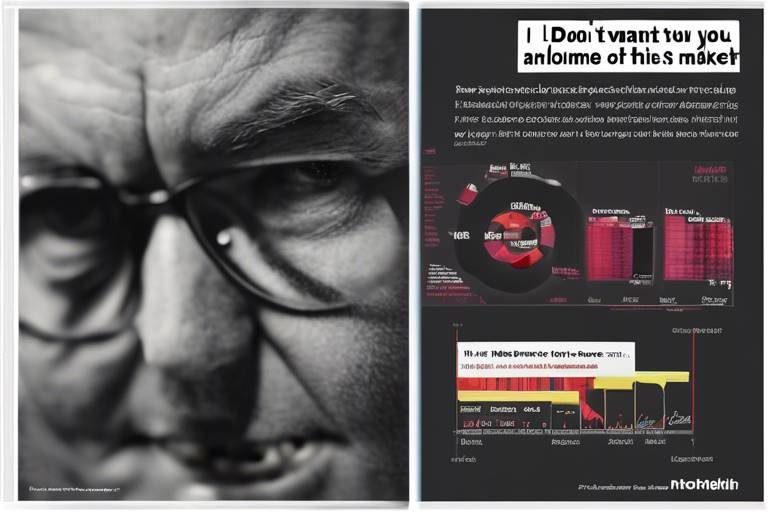The Role of Analytics in Predicting Market Movements
In today's fast-paced financial landscape, the ability to predict market movements is more crucial than ever. Investors are constantly seeking ways to gain an edge, and this is where analytics come into play. By leveraging data and advanced analytical techniques, market participants can enhance their decision-making processes, ultimately leading to more effective investment strategies. But what exactly does this mean? Let's dive deeper into the world of analytics and explore how it shapes our understanding of market trends.
At its core, analytics involves the systematic analysis of data to extract meaningful insights. In the context of financial markets, this means examining vast amounts of information—everything from historical price movements to economic indicators. The goal? To identify patterns and trends that can inform future actions. Imagine trying to predict the weather without any data; it would be nearly impossible! Similarly, predicting market movements without robust analytics is akin to navigating a ship without a compass.
One of the most compelling aspects of analytics is its ability to transform raw data into actionable insights. By utilizing different types of analytics—descriptive, predictive, and prescriptive—investors can gain a comprehensive view of the market. For instance, descriptive analytics allows traders to look back at historical data, uncovering trends that can inform current strategies. Predictive analytics, on the other hand, employs statistical models and machine learning techniques to forecast future market behavior. This dual approach not only enhances understanding but also empowers investors to make informed decisions based on solid evidence rather than gut feelings.
In a world where information is abundant yet overwhelming, analytics serve as a guiding light. They help investors sift through the noise and focus on what truly matters. By integrating analytics into their investment strategies, traders can better assess risks and opportunities, ultimately leading to improved portfolio management. Think of it as having a personal trainer for your investments; analytics provide the insights needed to optimize performance and achieve financial goals.
As we look ahead, the role of analytics in finance is set to expand even further. With advancements in technology, we can expect greater accuracy and efficiency in data analysis. Emerging tools and platforms are transforming how investors approach market predictions, making it easier to access real-time data and insights. The future of analytics in finance is bright, and those who embrace these tools will likely find themselves at a significant advantage in the ever-evolving market landscape.
Data serves as the foundation for market analysis. Understanding its significance helps investors make informed decisions and identify potential trends that can influence market movements. Without quality data, any analysis is merely speculation. This importance is underscored by the fact that financial markets are driven by information. Every tick in stock prices, every economic report, and every news headline can sway market sentiment. Therefore, having access to accurate and timely data is essential for any investor looking to navigate these turbulent waters.
Different types of analytics, including descriptive, predictive, and prescriptive, each play unique roles in financial market analysis, offering insights into past performance and future trends. Each type has its own strengths and applications, making them invaluable tools in the investor's toolkit.
Descriptive analytics focuses on historical data to provide insights into what has happened in the market, helping traders understand past trends and patterns. This type of analysis is like looking in a rearview mirror; it allows investors to see where they have been, which can inform where they are going.
Various tools and software are available to assist in descriptive analysis, enabling investors to visualize data and derive meaningful insights from historical trends. Some popular tools include:
- Tableau
- Microsoft Excel
- Google Data Studio
- Power BI
These platforms help investors create compelling visualizations that make data easier to understand and interpret.
Despite its usefulness, descriptive analytics faces challenges such as data quality and the potential for misinterpretation, which can lead to incorrect conclusions about market movements. Investors must be cautious and ensure they are using reliable data sources to avoid pitfalls.
Predictive analytics utilizes statistical techniques and machine learning to forecast future market movements, allowing investors to anticipate changes and adjust their strategies accordingly. This proactive approach can be likened to having a crystal ball; it helps investors prepare for potential market shifts before they happen.
Incorporating analytics into investment strategies enhances decision-making capabilities, enabling investors to leverage data-driven insights for better portfolio management and risk assessment. By harnessing the power of analytics, traders can make informed choices that align with their financial goals.
Real-time analytics provides immediate insights into market conditions, helping traders make quick decisions based on the latest data available. In the world of finance, timing is everything, and having access to real-time information can be the difference between profit and loss.
As technology advances, the future of analytics in finance promises greater accuracy and efficiency, with emerging tools transforming how investors approach market predictions. The integration of artificial intelligence and machine learning will likely lead to even more sophisticated analytical capabilities, allowing for deeper insights and more precise forecasting.
1. What is the primary role of analytics in finance?
Analytics help investors make informed decisions by analyzing historical data and forecasting future trends, ultimately leading to better investment strategies.
2. How can I start using analytics for my investments?
Begin by familiarizing yourself with descriptive and predictive analytics tools. Start analyzing historical data and gradually incorporate predictive models to forecast future market movements.
3. What are some common challenges in using analytics?
Common challenges include data quality issues, the potential for misinterpretation, and the need for specialized knowledge to analyze complex data sets effectively.

The Importance of Data in Market Analysis
In the fast-paced world of finance, data is king. Imagine trying to navigate a bustling city without a map; that’s what investing feels like without accurate data. Data serves as the foundation for market analysis, providing the essential insights that guide investors in their decision-making processes. The significance of understanding market data cannot be overstated, as it helps investors identify potential trends that can profoundly influence market movements.
When we talk about data in market analysis, we're referring to a vast array of information, including historical prices, trading volumes, economic indicators, and even social sentiment. Each piece of data acts like a puzzle piece, contributing to a clearer picture of market dynamics. For instance, consider how economic indicators such as GDP growth rates or unemployment figures can sway investor sentiment. A sudden increase in unemployment might signal a downturn, prompting investors to reconsider their strategies.
Furthermore, the advent of technology has transformed how we collect and analyze data. With tools like big data analytics and machine learning, investors can sift through mountains of information to uncover hidden patterns and correlations. This process not only enhances the accuracy of forecasts but also allows for a more nuanced understanding of market behavior. As a result, investors can react swiftly to changes, positioning themselves advantageously in the market.
However, it’s important to remember that not all data is created equal. The quality of data plays a crucial role in its usefulness for analysis. Inaccurate or outdated data can lead to misguided decisions, potentially resulting in significant financial losses. Therefore, investors must prioritize sourcing reliable data from reputable providers and ensuring they are interpreting it correctly. This includes being aware of biases that may skew the analysis.
In summary, the importance of data in market analysis cannot be overstated. It empowers investors to make informed decisions, anticipate market trends, and ultimately enhance their investment strategies. As we continue to navigate an increasingly complex financial landscape, the ability to leverage data effectively will be a key differentiator for successful investors.

Types of Analytics Used in Finance
When it comes to navigating the complex waters of finance, understanding the different types of analytics is like having a map and compass at your disposal. Each type of analytics serves a unique purpose, shedding light on various aspects of market behavior. The three primary types of analytics used in finance are descriptive analytics, predictive analytics, and prescriptive analytics. Each of these plays a crucial role in helping investors and analysts make informed decisions based on data.
Descriptive analytics is the starting point for any financial analysis. It involves examining historical data to uncover trends and patterns that have occurred in the market. By analyzing past performance, investors can gain insights into what has worked and what hasn’t. Think of it as looking in the rearview mirror while driving; it helps you understand where you’ve been, which is essential for determining your next move. For instance, if a stock has consistently risen during a particular season in the past, that information can influence future investment decisions.
To effectively harness descriptive analytics, various tools and software are available that can help visualize data, making it easier to digest. These tools can generate charts, graphs, and reports that highlight key performance indicators (KPIs). However, it’s important to note that while descriptive analytics can provide valuable insights, it is not without its challenges. Data quality is paramount; poor-quality data can lead to misinterpretations, resulting in misguided conclusions about market movements. Therefore, investors must ensure that the data they rely on is accurate and relevant.
Next up is predictive analytics, which takes things a step further by employing statistical techniques and machine learning algorithms to forecast future market movements. This type of analytics is akin to a crystal ball for investors, allowing them to anticipate market changes and adjust their strategies accordingly. For example, predictive models can analyze various factors, such as economic indicators and market sentiment, to predict stock price movements. This proactive approach can significantly enhance an investor's ability to capitalize on emerging opportunities.
Predictive analytics relies heavily on historical data, but it also incorporates real-time information to refine its forecasts. By continuously updating models with the latest data, investors can react swiftly to market changes. It’s like having a weather app that not only tells you the forecast for tomorrow but also updates you on sudden changes in weather patterns. However, just like any forecast, predictive analytics comes with its own set of uncertainties. Market conditions can change rapidly, and unexpected events can disrupt even the most sophisticated models.
Finally, we have prescriptive analytics, which is the most advanced type of analytics in finance. This approach goes beyond merely predicting future outcomes; it provides actionable recommendations based on the data analyzed. Imagine you’re not just told that it might rain tomorrow, but also advised on whether you should carry an umbrella or wear a raincoat. Prescriptive analytics uses optimization and simulation algorithms to suggest the best course of action to achieve specific financial goals, such as maximizing returns or minimizing risks.
In summary, the landscape of financial analytics is rich and varied, with each type playing a vital role in shaping investment strategies. Descriptive analytics helps us understand the past, predictive analytics allows us to foresee potential futures, and prescriptive analytics guides us in making the best decisions moving forward. By leveraging these analytics, investors can transform raw data into powerful insights, enabling them to navigate the ever-changing financial markets with confidence.
As we continue to explore the evolving role of analytics in finance, it's crucial to stay informed about the latest tools and techniques that can enhance our understanding and decision-making capabilities. The integration of these analytics into investment strategies is not just beneficial; it’s essential in today’s fast-paced financial environment.

Descriptive Analytics
Descriptive analytics is like looking in the rearview mirror while driving; it helps investors understand the journey they've taken through the financial landscape. By analyzing historical data, descriptive analytics provides valuable insights into past market behaviors, trends, and patterns. Think of it as a storyteller that narrates what has already occurred, allowing traders to glean lessons from previous market movements. This type of analytics can be particularly useful for identifying seasonal trends, price fluctuations, and the impact of major events on market performance.
One of the key aspects of descriptive analytics is its ability to aggregate vast amounts of data into digestible formats. Investors can utilize various tools and software that transform raw data into visual representations, such as charts and graphs. For instance, a well-structured table can summarize historical price movements, providing a clear overview of how a particular asset has performed over time. Here’s a simple example:
| Year | Price ($) | Market Trend |
|---|---|---|
| 2020 | 50 | Stable |
| 2021 | 75 | Rising |
| 2022 | 60 | Declining |
| 2023 | 90 | Recovering |
However, while descriptive analytics can unveil the stories of the past, it’s not without its challenges. One major obstacle is data quality. If the input data is flawed or incomplete, the insights derived from it can be misleading, leading to poor investment decisions. Additionally, there’s the risk of misinterpretation. Investors must tread carefully, as drawing conclusions based solely on historical data can sometimes overlook the nuances of current market conditions.
In essence, descriptive analytics serves as a critical foundation for market analysis. It equips investors with the necessary context to make informed decisions, but it should always be complemented by other forms of analytics to create a well-rounded investment strategy. By understanding what has happened, investors can better prepare for what lies ahead, merging the lessons of the past with the possibilities of the future.

Tools for Descriptive Analysis
This article explores how analytics play a crucial role in forecasting market trends, enhancing decision-making, and improving investment strategies in today's dynamic financial landscape.
Data serves as the foundation for market analysis. Understanding its significance helps investors make informed decisions and identify potential trends that can influence market movements.
Different types of analytics, including descriptive, predictive, and prescriptive, each play unique roles in financial market analysis, offering insights into past performance and future trends.
Descriptive analytics focuses on historical data to provide insights into what has happened in the market, helping traders understand past trends and patterns.
When it comes to descriptive analytics, the right tools can make all the difference. These tools are designed to help investors sift through vast amounts of historical data, uncovering patterns and trends that might otherwise go unnoticed. Some of the most popular tools include:
- Excel: A staple in data analysis, Excel offers powerful functions for data manipulation and visualization.
- Tableau: This tool is renowned for its ability to create stunning visual representations of data, making it easier for investors to grasp complex trends.
- Power BI: Developed by Microsoft, Power BI allows users to create interactive reports and dashboards, providing a comprehensive view of market data.
- R and Python: These programming languages are essential for more advanced statistical analysis, enabling users to perform complex calculations and generate insights from large datasets.
Utilizing these tools, investors can visualize data through charts, graphs, and dashboards, making it easier to digest and understand the information at hand. For instance, a simple line graph can reveal trends over time, while a bar chart can compare different market segments. The visual aspect is not just for aesthetics; it plays a critical role in highlighting important data points that might be overlooked in raw numerical formats.
However, it's important to note that while these tools are incredibly powerful, they are not without their challenges. Data quality is a significant concern; if the data fed into these tools is flawed or incomplete, the insights generated can lead to misinterpretations. Additionally, the complexity of some tools may deter less tech-savvy investors from fully utilizing their capabilities. Therefore, investing time in learning these tools is as crucial as the data itself.
Predictive analytics utilizes statistical techniques and machine learning to forecast future market movements, allowing investors to anticipate changes and adjust their strategies accordingly.
Incorporating analytics into investment strategies enhances decision-making capabilities, enabling investors to leverage data-driven insights for better portfolio management and risk assessment.
Real-time analytics provides immediate insights into market conditions, helping traders make quick decisions based on the latest data available.
As technology advances, the future of analytics in finance promises greater accuracy and efficiency, with emerging tools transforming how investors approach market predictions.
Q: What is the primary purpose of descriptive analytics in finance?
A: Descriptive analytics helps investors understand past market behavior by analyzing historical data, which can inform future investment decisions.
Q: Can I use free tools for descriptive analysis?
A: Yes, there are several free tools available, such as Google Sheets and various open-source software options that can assist in basic descriptive analytics.
Q: How does predictive analytics differ from descriptive analytics?
A: While descriptive analytics analyzes past data to explain what has happened, predictive analytics uses that data to forecast what might happen in the future.

Challenges in Descriptive Analytics
Descriptive analytics, while immensely valuable, comes with its own set of challenges that can hinder its effectiveness. One of the primary issues is data quality. If the data being analyzed is inaccurate, outdated, or incomplete, the insights generated will be flawed. Imagine trying to navigate a ship using a map that hasn't been updated in years; you might end up lost or, worse, sailing into dangerous waters.
Another significant challenge is the potential for misinterpretation. Analysts may draw conclusions based on historical data that don't account for current market conditions or external factors. For instance, a spike in stock prices due to a temporary event might be misread as a long-term trend. This misinterpretation can lead to poor investment decisions, akin to betting all your chips on a hand that seems strong but is actually weak.
Moreover, the sheer volume of data available today can be overwhelming. Investors might struggle to filter through the noise and focus on the most relevant information. This is where advanced tools come into play, but they also introduce complexity. Users must be trained to utilize these tools effectively; otherwise, they risk misusing them, which can further complicate their analyses.
To illustrate these challenges, consider the following table that summarizes the key obstacles faced in descriptive analytics:
| Challenge | Description |
|---|---|
| Data Quality | Inaccurate or outdated data can lead to misleading insights. |
| Misinterpretation | Analysts may misread data trends, leading to poor decisions. |
| Data Overload | The vast amount of data can overwhelm analysts, making it hard to focus on key insights. |
| Tool Complexity | Advanced tools require training and can be misused without proper knowledge. |
In conclusion, while descriptive analytics provides a window into historical performance and trends, investors must navigate these challenges carefully. Recognizing the limitations and potential pitfalls is crucial for making informed decisions. After all, in the world of finance, where every second counts, a misstep can lead to significant losses.
Q1: What is descriptive analytics?
Descriptive analytics is the process of analyzing historical data to understand what has happened in the past. It helps identify trends and patterns that can inform future decisions.
Q2: Why is data quality important in descriptive analytics?
Data quality is crucial because inaccurate or incomplete data can lead to misleading insights, which can result in poor investment decisions.
Q3: How can misinterpretation of data be avoided?
To avoid misinterpretation, it's essential to consider the context of the data, including current market conditions and external factors, and to utilize advanced analytical tools correctly.
Q4: What tools can help with descriptive analytics?
There are various tools available for descriptive analytics, such as Tableau, Microsoft Power BI, and Google Analytics, which help visualize and interpret data effectively.

Predictive Analytics
Predictive analytics is like having a crystal ball in the world of finance. It harnesses the power of statistical techniques and machine learning to forecast future market movements. Imagine being able to anticipate the next big shift in stock prices or commodity values before it happens! This capability allows investors to stay one step ahead of the game, adjusting their strategies based on what the data suggests will occur. By analyzing historical data patterns, predictive analytics can provide insights that help traders make informed decisions, potentially leading to increased profits and reduced risks.
The process of predictive analytics involves several steps. First, data is collected from various sources, including market trends, economic indicators, and even social media sentiment. This data is then cleaned and organized to ensure accuracy. Next, sophisticated algorithms are applied to identify patterns and correlations that may not be immediately obvious. For instance, a predictive model might reveal that a particular stock tends to rise when certain economic indicators improve, allowing investors to capitalize on this trend.
One of the most exciting aspects of predictive analytics is its ability to evolve. As more data becomes available and technology advances, the models become increasingly accurate. This is akin to a chef perfecting a recipe over time; the more you experiment, the better the dish becomes. In finance, this means that predictive models can adapt to changing market conditions, providing investors with the most relevant insights possible.
However, it's important to note that predictive analytics is not foolproof. While it can significantly enhance decision-making, there are inherent risks. Market conditions can change rapidly due to unforeseen events, such as political upheaval or natural disasters, which may not be accounted for in the models. Therefore, investors should use predictive analytics as a tool, not a guarantee. It's about combining data-driven insights with human intuition and experience.
In conclusion, predictive analytics is revolutionizing the way investors approach the market. By leveraging data and advanced algorithms, traders can make more informed decisions and potentially improve their investment outcomes. As technology continues to progress, the future of predictive analytics in finance looks incredibly promising, offering even more sophisticated tools to help investors navigate the complexities of the financial landscape.
- What is predictive analytics?
Predictive analytics refers to the use of statistical techniques and machine learning to analyze historical data and forecast future outcomes, particularly in financial markets.
- How does predictive analytics benefit investors?
It helps investors anticipate market changes, allowing them to adjust their strategies proactively, potentially leading to better returns and reduced risks.
- Are there risks associated with predictive analytics?
Yes, while predictive analytics can provide valuable insights, it is not infallible. Sudden market changes due to unforeseen events can impact the accuracy of predictions.
- Can predictive analytics adapt to changing market conditions?
Absolutely! As more data is collected and technology evolves, predictive models can be updated to reflect new patterns and trends in the market.

Integrating Analytics into Investment Strategies
In today's fast-paced financial landscape, integrating analytics into investment strategies is not just a luxury; it’s a necessity. Imagine trying to navigate through a dense fog without a compass—this is what investing without analytics feels like. By leveraging data-driven insights, investors can enhance their decision-making capabilities, making informed choices that align with market trends. Analytics provide a clear path through the noise of market fluctuations, allowing investors to pinpoint opportunities that might otherwise go unnoticed.
One of the primary benefits of integrating analytics into investment strategies is the ability to perform data-driven decision-making. When investors rely on historical data, they can identify patterns and trends that inform their future actions. For instance, if a particular sector has shown consistent growth over the past few years, analytics can help investors recognize this trend and adjust their portfolios accordingly. This proactive approach can lead to improved returns and reduced risk.
Moreover, analytics can significantly enhance risk assessment. By analyzing various data points—such as market volatility, economic indicators, and historical performance—investors can better understand the risks associated with specific investments. This allows them to create a more balanced and resilient portfolio. For example, an investor might use predictive analytics to forecast potential downturns in the market, enabling them to shift their investments before losses occur.
Another crucial aspect of integrating analytics is the incorporation of real-time data. In a world where market conditions can change in an instant, having access to real-time analytics allows investors to make swift decisions based on the latest information. For instance, a sudden shift in economic policy or a major event affecting a specific industry can drastically influence stock prices. By utilizing real-time analytics, investors can react promptly, capitalizing on opportunities or mitigating losses.
As technology continues to evolve, new tools are emerging that make it easier for investors to integrate analytics into their strategies. From advanced software solutions that offer predictive modeling to platforms providing real-time market data, the options are vast. These tools not only streamline the analysis process but also enhance the accuracy of predictions, allowing investors to make more confident decisions.
However, it’s essential to acknowledge that while analytics provide valuable insights, they should not be the sole basis for investment decisions. Human intuition and experience still play a critical role in interpreting data and understanding market dynamics. Therefore, the most effective investment strategies are those that combine the power of analytics with seasoned judgment. This synergy can lead to a more comprehensive understanding of the market, ultimately resulting in better investment outcomes.
To summarize, integrating analytics into investment strategies is a game-changer for investors. By harnessing the power of data, they can improve their decision-making processes, enhance risk assessment, and react swiftly to market changes. As we look to the future, the role of analytics in finance will only continue to grow, transforming the way investors approach the market.
- What is the primary benefit of using analytics in investing?
Analytics help investors make informed decisions by providing insights into market trends and patterns. - How can real-time analytics improve investment strategies?
Real-time analytics allow investors to respond quickly to market changes, optimizing their investment decisions. - Can analytics replace human intuition in investing?
No, while analytics provide valuable data, human intuition and experience are crucial for interpreting that data effectively. - What tools are available for integrating analytics into investment strategies?
There are numerous software solutions and platforms that offer predictive modeling and real-time market data to enhance investment strategies.

Real-time Analytics
In today’s fast-paced financial landscape, has emerged as a game-changer for investors and traders alike. Imagine standing on the edge of a bustling market, where every second counts, and the slightest shift can lead to significant gains or losses. Real-time analytics provides that edge, enabling investors to tap into immediate insights and make swift decisions based on the latest market data.
What sets real-time analytics apart is its ability to process data as it becomes available. This means that rather than relying solely on historical trends or delayed reports, investors can monitor market movements in the moment, adapting their strategies dynamically. For instance, if a stock suddenly spikes due to breaking news, real-time analytics allows traders to react instantly, seizing opportunities that would otherwise slip away.
Moreover, the integration of advanced technologies like Artificial Intelligence (AI) and Machine Learning (ML) into real-time analytics platforms has revolutionized how data is interpreted. These technologies can identify patterns and anomalies at lightning speed, providing insights that are not only timely but also predictive. For example, an AI-powered tool might analyze trading volumes, social media sentiment, and economic indicators simultaneously to forecast potential market shifts.
However, while the benefits of real-time analytics are undeniable, it’s essential to recognize that it also comes with challenges. The sheer volume of data can be overwhelming, and without the right tools, investors may find it difficult to discern valuable insights from noise. Additionally, the risk of making hasty decisions based on fleeting data can lead to costly errors. Thus, it’s crucial for investors to balance speed with thorough analysis.
To illustrate the impact of real-time analytics, consider the following table that outlines its key benefits:
| Benefit | Description |
|---|---|
| Immediate Insights | Access to up-to-the-minute data allows for rapid decision-making. |
| Enhanced Accuracy | Real-time data reduces the lag in information, improving forecast precision. |
| Competitive Advantage | Investors can capitalize on market movements before competitors react. |
| Risk Management | Quickly identify potential risks and adjust positions accordingly. |
In conclusion, real-time analytics is not just a tool; it's a vital component of modern trading strategies. By leveraging immediate data and advanced technologies, investors can navigate the complexities of the market with greater confidence and agility. As we move forward, the role of real-time analytics will only continue to grow, shaping the future of investment strategies and market predictions.
- What is real-time analytics? Real-time analytics refers to the immediate processing and analysis of data as it becomes available, allowing for quick decision-making in financial markets.
- How does real-time analytics benefit investors? It provides timely insights, enhances accuracy, and allows investors to respond quickly to market changes, thus gaining a competitive edge.
- What technologies are used in real-time analytics? Technologies such as Artificial Intelligence (AI) and Machine Learning (ML) are commonly used to analyze data and predict market movements in real-time.
- Are there any challenges associated with real-time analytics? Yes, challenges include the overwhelming volume of data and the risk of making hasty decisions based on incomplete information.

The Future of Analytics in Finance
The future of analytics in finance is not just a trend; it's a revolution that is set to reshape the entire landscape of investment and trading strategies. As we step into an era dominated by technology, the integration of advanced analytics tools is becoming increasingly crucial. Imagine a world where financial decisions are not just based on gut feelings but are backed by robust data analysis and predictive modeling. This is the reality that is unfolding right before our eyes.
One of the most exciting aspects of this future is the rise of artificial intelligence (AI) and machine learning (ML). These technologies are not merely buzzwords; they are powerful tools that enable financial analysts to process vast amounts of data at lightning speed. By utilizing algorithms that can learn from historical data, financial institutions can better predict market movements and identify potential risks. This shift towards AI-driven analytics means that investors will have access to insights that were previously unimaginable, allowing for more informed decision-making.
Moreover, the advent of big data is another game-changer. With the ability to analyze data from various sources, including social media, economic indicators, and even weather patterns, investors can gain a holistic view of the market. This comprehensive understanding helps in identifying trends and making predictions that are more accurate. For instance, a trader might analyze sentiment data from social media platforms to gauge public opinion about a particular stock, providing them with an edge in their investment strategy.
However, with great power comes great responsibility. The future of analytics also raises questions about data privacy and security. As financial institutions collect and analyze more data, they must ensure that they are compliant with regulations and that they protect sensitive information. This challenge will require a delicate balance between leveraging data for insights and maintaining the trust of clients and stakeholders.
Furthermore, the continuous evolution of technology means that investors must stay abreast of the latest tools and methodologies. This requires a commitment to ongoing education and adaptation. Financial professionals who embrace these changes will undoubtedly find themselves at a significant advantage. The landscape is shifting, and those who resist change may find themselves left behind.
In conclusion, the future of analytics in finance is bright and full of potential. With advancements in AI, big data, and real-time analytics, investors are poised to make smarter, data-driven decisions. As we navigate this exciting frontier, it's essential to remain vigilant about the ethical implications and to prioritize data security. The journey ahead is not just about numbers; it's about shaping the future of finance itself.
- What role does AI play in financial analytics?
AI enhances financial analytics by enabling faster data processing and predictive modeling, allowing for more accurate forecasts and informed decision-making.
- How does big data affect investment strategies?
Big data provides a comprehensive view of market trends by analyzing diverse sources of information, leading to more strategic investment decisions.
- What are the challenges of using analytics in finance?
Challenges include ensuring data privacy, maintaining data quality, and the need for continuous education to keep up with evolving technologies.
Frequently Asked Questions
- What is the role of analytics in predicting market movements?
Analytics play a pivotal role in predicting market movements by analyzing vast amounts of data to identify trends and patterns. This helps investors make informed decisions and develop strategies that align with market forecasts.
- Why is data important for market analysis?
Data is the backbone of market analysis. It provides the necessary insights that help investors understand past performances, recognize current trends, and predict future movements. Without accurate data, decision-making can become guesswork.
- What types of analytics are commonly used in finance?
In finance, the three main types of analytics are descriptive, predictive, and prescriptive. Descriptive analytics focuses on historical data, predictive analytics forecasts future trends, and prescriptive analytics suggests actions based on data insights.
- How does descriptive analytics benefit investors?
Descriptive analytics helps investors by providing a clear picture of what has happened in the market. This understanding of historical data allows traders to identify patterns and make better decisions based on past performance.
- What challenges do investors face with descriptive analytics?
Investors often encounter challenges such as data quality issues and the potential for misinterpretation of data. These challenges can lead to incorrect conclusions and poor investment decisions if not addressed properly.
- How does predictive analytics work?
Predictive analytics uses statistical techniques and machine learning algorithms to analyze historical data and forecast future market movements. This allows investors to anticipate changes and adjust their strategies proactively.
- What is real-time analytics and how does it help traders?
Real-time analytics refers to the immediate processing and analysis of data as it becomes available. This capability enables traders to make quick and informed decisions based on the latest market conditions, enhancing their trading effectiveness.
- What does the future hold for analytics in finance?
The future of analytics in finance looks promising, with advancements in technology leading to greater accuracy and efficiency. Emerging tools and techniques are expected to transform how investors approach market predictions, making analytics even more integral to investment strategies.



















